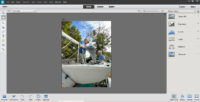Ron Proctor and Amy Jo Proctor built a 3-D video system for only $250. If you have anaglyph glasses with a blue left lens and red right lens, you’ll see such videos in 3-D. Essentially, their system uses two Kodak Zx1 Cameras on a 6.5cm baseline. That’s similar to the human eye baseline. The cameras were started manually.
Then in a non-linear video editor, Adobe Premiere CS4, they overlaid the two tracks and set the compositing mode to “screen.” This is called “add” in some editors. They removed the red channel from the right, and then removed the blue and green channels from the left.
They said We also had to adjust the offset a little bit so the “focus” was on one of the middle birds. Whatever the two channels “line up” on will be the “focus,” also known as the “screen plane depth.” Whatever is in front of that will “pop out” and whatever is behind will “pop in.”
How Anaglyph Works
Anaglyphs are traditional 3-D images like we’ve seen for decades in print, movies and TV. Viewing anaglyph images through colored glasses results in each eye seeing a slightly different picture. In a red-blue anaglyph, for instance, the eye with the red filter sees the red parts of the image as “white”, and the blue parts as “black.”. The eye with the blue filter perceives the opposite effect. True white or true black areas are perceived the same by each eye. The brain blends together the image it receives from each eye, and interprets the differences as being the result of different distances.






How to Produce Your Own 3D Video
This can also be easily accomplished within After Effects using the ‘3D Glasses” plugin after layering your left and right video tracks. Just fiddle with the ‘convergence’ setting.